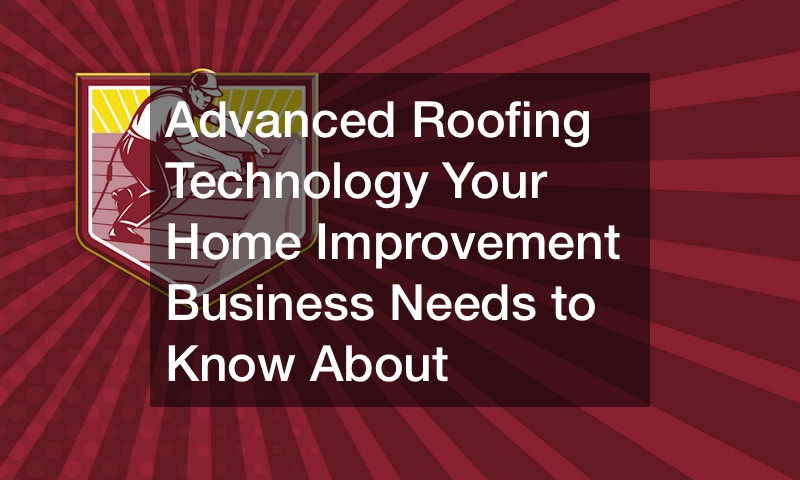Changing technology has touched practically every single aspect of our lives. This means that even construction has not been left behind, with the roofing industry seeing the most changes. This means that it’s no longer enough to simply know the basics of how to fix a garage roof. You should know the most effective and sustainable method how to repair a garage roof so that you can appeal to more customers.
Roofers need to keep learning to keep up with emerging trends in materials, marketing, and more. With such knowledge, you can have more authority in the industry and the people who hire you will be sure to keep coming back. They’ll also make referrals to your business in their circles. As a result, you may not have to work too hard at making your name known because you’ll have the advantage of having amazing reviews from former clients.

People should still be able to find you in the results when they search for something like “fix garage roof” or “garage roof replacement near me.” Achieve this by maintaining a professional online presence so that you can reach more people digitally as well. As a result, you can scale up and grow your roofing business beyond your wildest dreams.
Are you looking to take your home improvement business to the next level? Discover the game-changing world of advanced roofing technology that you need to know about. Stay ahead of the competition by exploring the latest innovations in materials, design, and energy efficiency. The insights in this guide will position you as a leader in the industry and set your business apart. Continue reading to find out how o stay ahead of the game.
Solar Roofing

Solar roofing, as an advanced roofing technology, involves the integration of solar panels or solar shingles into traditional roof structures. This innovative approach allows buildings to harness the power of the sun and generate clean, renewable electricity. It utilizes photovoltaic technology to convert sunlight into usable energy, reducing dependence on fossil fuels and decreasing carbon emissions.
The installation process of solar roofing typically requires the use of specialized solar roof equipment. This can include solar panels, which are mounted on the roof using racking systems, or solar shingles, which are designed to blend seamlessly with the rest of the roof surface. These solar roof components capture sunlight and convert it into usable electricity through the photovoltaic effect, enabling the building to generate its own power and potentially even feed excess energy back into the grid.
Pricing of a solar roofing system can vary depending on factors such as the size of the system, location, and equipment quality. On average, you can charge between $15,000 to $25,000 for residential solar roofing installation. It’s, however, important to note that prices can be influenced by incentives, tax credits, and local solar policies, which may offset the initial investment. Over time, solar roofing systems provide your clients with significant savings on energy bills.
Impact-Resistant Roofing Materials

As a Home Improvement Business owner, it’s important to be well-versed in impact-resistant roofing materials to meet the needs of your customers. These materials are specifically designed to withstand severe weather conditions, such as hail, debris, and high winds, providing enhanced durability and protection for roofs. Common examples of impact-resistant roofing materials include asphalt shingles with Class 4 ratings, metal roofing systems, and synthetic composites.
The installation process for impact-resistant roofing materials requires the expertise of skilled professionals. Proper installation techniques ensure that the materials perform optimally and offer maximum protection. You can partner with experienced roof repair services who specialize in working with these advanced materials, ensuring that the installation is carried out to industry standards and meets the specific requirements of each project.
To get impact-resistant roofing materials at the best price you can follow several strategies. Stay informed about advancements in roofing technology to identify cost-effective options that maintain high quality. Establish relationships with reputable suppliers who offer competitive pricing and consider bulk purchasing to leverage discounts. Also, take advantage of any available incentives, rebates, or special offers from manufacturers or local authorities to help reduce the overall cost for your customers.
Green Roofing
Understanding green roofing and its significance is necessary for providing innovative solutions to your customers. Green roofing, also known as living roofs or eco-roofs, involves the application of advanced roofing technology to create a vegetated space on the roof of a building. It combines the traditional function of a roof with the benefits of greenery, offering environmental advantages and aesthetic appeal to property owners.
When it comes to green roofing, careful plant selection is key. Different plant species are chosen based on factors such as climate, roof structure, and maintenance requirements. Drought-resistant plants, native species, and those with shallow root systems are often preferred to ensure optimal growth and sustainability. Help your customers save money and protect the environment by offering green roofing service packages.
Green roofing has experienced wide adoption in recent years due to its numerous benefits. Data According to a recent report by Bridge Market Research report, “the green roof market is expected to witness market growth at a rate of approximately 15% in the forecast period of 2021 to 2028 and is expected to reach USD 3.87 billion by 2028.” This growth is driven by the advantages green roofing provides, including improved energy efficiency, stormwater management, air quality enhancement, and increased biodiversity in urban environments.
Synthetic Slate Shingles

Synthetic slate shingles are a remarkable product in the realm of roofing, utilizing advanced roofing technology to replicate the appearance and texture of natural slate. Made from high-quality polymer materials, these shingles offer a lightweight and durable alternative to traditional slate roofing. Their synthetic composition provides excellent resistance to impact, fire, and harsh weather conditions, ensuring long-lasting protection for homes.
The installation process of synthetic slate shingles is similar to that of traditional roofing materials. However, their lightweight nature makes them easier to handle and reduces the structural load on the building. Consider partnering with a local chimney business with expertise in roofing installations that can effectively handle the process, ensuring precise placement and proper sealing to maintain the shingles’ integrity.
One of the key advantages of synthetic slate shingles is their cost-effectiveness compared to natural slate. While natural slate can be expensive and challenging to source, synthetic slate shingles offer a more affordable and readily available option without compromising on aesthetics or performance. Homeowners can achieve the timeless beauty of slate roofing while enjoying the benefits of advanced technology and easier installation.
Metal Roofing with Integrated Solar Panels
Metal roofing with integrated solar panels presents an exciting opportunity for Home Improvement Businesses to offer advanced roofing technology that combines the benefits of both materials. The adoption of this innovative solution has been on the rise as homeowners recognize its numerous advantages. With the durability and longevity of metal roofing and the energy-generation capabilities of solar panels, customers can enjoy a sustainable and efficient roofing system.
A key advantage of metal roofing with integrated solar panels is the wide range of styles and options available. Homeowners can choose from various designs, such as standing seam metal roofs, metal tiles, or metal shingles. These solutions will seamlessly incorporate solar technology into their roofing system while maintaining an appealing aesthetic.
To provide this service, it’s important to comply with local regulations and building codes, which may require obtaining specific licenses and certifications. The qualifications of metal roofing contractors may relate to solar panel installation, electrical work, and general roofing practices. With the necessary requirements, you can confidently offer metal roofing with integrated solar panel installations, meeting the growing demand for sustainable and energy-efficient solutions.
Cool Roofing

Cool roofing refers to a type of roofing system that is designed to reflect a larger portion of sunlight and absorb less heat compared to traditional roofs. Through advanced technology and specialized materials, cool roofing offers numerous advantages. From reduced energy consumption and lower cooling costs to improved indoor comfort and the potential to mitigate the urban heat island effect, cool roofs are a must-add to your catalog.
Cool roofing materials encompass a range of options tailored to promote heat reflection. These can include reflective roof coatings, cool roof membranes, or specially designed cool roof shingles. These materials are engineered with properties that enable them to reflect sunlight and release absorbed heat efficiently, contributing to a cooler building interior.
To ensure client satisfaction, there are key tips to consider. First, educate your clients about the benefits of cool roofing, emphasizing energy savings and enhanced comfort. Second, collaborate with an experienced roofing contractor who specializes in cool roofing installations to ensure the proper material selection and precise installation techniques. Also, offer post-installation support and maintenance services to ensure the continued performance and longevity of the cool roofing system.
Self-Healing Roof Membranes
Self-healing roof membranes are an innovative solution that’s gaining attention in the roofing industry. These membranes have the remarkable ability to repair small punctures or cracks on their own, extending the lifespan of the roofing system. With a history rooted in advanced roofing technology, materials science, and engineering, self-healing roof membranes have evolved to provide enhanced durability and protection for buildings.
Installing self-healing roof membranes requires careful preparation and the use of appropriate tools. Before installation, the roof surface should be thoroughly cleaned and inspected for any existing damage. The membranes are typically applied using standard roofing techniques, such as adhering or mechanically fastening them to the roof substrate. Special attention should be given to ensure proper overlaps and seam sealing to maximize the self-healing capabilities of the membrane. Basic roofing tools, such as utility knives, rollers, and adhesive applicators, are typically sufficient for the installation process.
Pricing for this innovative residential and commercial roofing service can differ depending on factors such as the size and complexity of the roof, the quality and brand of the membrane, and the level of expertise required for the installation. It’s recommended to conduct a thorough assessment of each project, considering material costs, labor, and any additional services provided, such as roof inspection or maintenance. Make sure to accurately price your services, taking into account the unique aspects of each project for a fair and competitive offering.
Smart Roof Systems with Sensors and Automation
Smart roof systems with sensors and automation have emerged as a groundbreaking application of advanced roofing technology, transforming the way buildings are managed and maintained. These intelligent systems incorporate various sensors and automation features to monitor and control critical aspects of the roof, enhancing efficiency, safety, and sustainability. These features not only improve the performance and durability of roofs but also contribute to a more sustainable and intelligent built environment.
Additionally, equipped with sensors, smart roof systems can continuously monitor environmental conditions such as temperature, humidity, and moisture levels. This real-time data enables proactive detection of issues like leaks or excessive heat buildup, allowing for timely intervention by a local roofing company to prevent further damage or energy wastage. Automation features within the system can autonomously adjust ventilation, insulation, or shading components to optimize energy usage and indoor comfort based on the collected sensor data.
The integration of smart roof systems is gaining traction, with market reports estimating that the global smart roof market will reach $142.88 billion by 2025. This growth is driven by the increasing demand for energy-efficient and sustainable building solutions. Smart roof systems offer significant benefits, including reduced energy consumption, improved occupant comfort, and enhanced building longevity, making them an attractive option for both residential and commercial properties.
Integrated Rainwater Harvesting Systems
Integrated rainwater harvesting systems are a valuable addition to any roofing project, offering numerous benefits to your clients through the utilization of advanced roofing technology. These systems utilize advanced roofing technology for the collection and storage of rainwater from the roof, which can be used for various purposes such as landscape irrigation, toilet flushing, and even potable water supply in some cases.
To install an integrated rainwater harvesting system, you will need specific tools, with a particular focus on gutter installation. Properly designed and installed gutters and downspouts are essential for efficiently directing rainwater into storage tanks or reservoirs. Tools such as measuring tape, level, drill, and ladder will be required to ensure accurate and secure gutter installation. For a complex integrated rainwater harvesting system, you may need rainwater diverters, first flush devices, water level indicators, and pressure regulators.
In addition to the installation process, it’s worth considering collaborating with a gutter guard company. Gutter guards help prevent debris and leaves from clogging the gutters, ensuring optimal water flow and minimizing the maintenance required for the rainwater harvesting system. With the help of a seasoned gutter guard company, you can provide your clients with a comprehensive solution that maximizes the efficiency and longevity of their rainwater harvesting system.
A thorough understanding of advanced roofing technology is essential for Home Improvement Businesses to thrive in today’s competitive market. Embracing these innovative solutions allows you to diversify your services, attract a wider customer base, and deliver cutting-edge roofing solutions. Building partnerships with local professionals and obtaining the required licenses and certifications enables you to confidently offer these technologies, ensuring customer satisfaction and establishing your business as an industry leader of metal roofing contractors.





